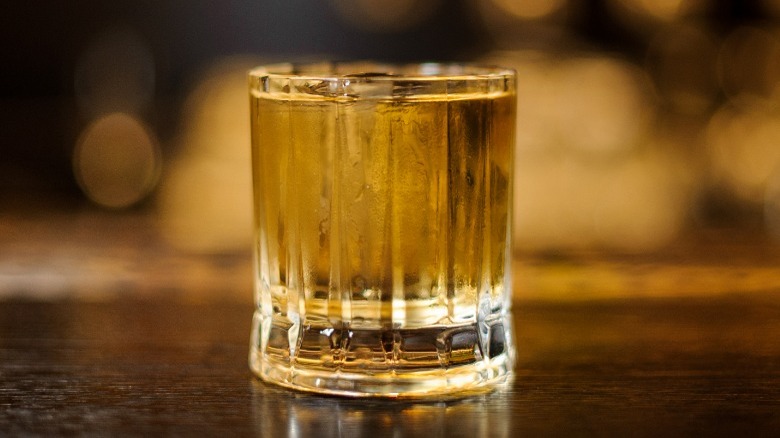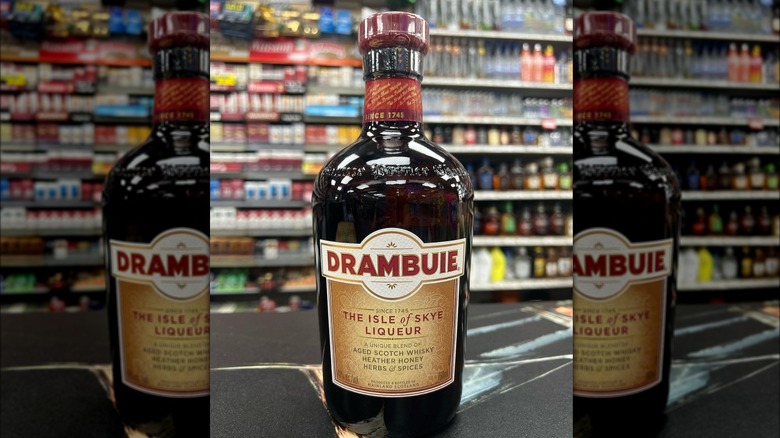The Origin Of The Rusty Nail — Frank Sinatra's Go-To Cocktail
Frank Sinatra is a legend known for his smooth crooner voice, as well as his acting chops. While his music is immediately recognizable, Old Blue Eyes also had a great love of whiskey and cocktails. Sinatra's go-to cocktail is one not often found on drink menus today: the Rusty Nail. This curiously-named concoction was the singer's drink of choice when he made trips to P.J. Clarke's, a famous restaurant and bar in New York City.
The Rusty Nail is a simple two-ingredient cocktail. All you need is Scotch whisky (from your region of choice) and Drambuie, a unique liqueur that also uses a base of Scotch. If you can manage to find this rare ingredient, making the drink is a piece of cake. As with most old-time cocktails, recipes and exact measurements vary, but a two-to-one ratio of Scotch to Drambuie is a good bet when making Sinatra's favorite beverage. Simply combine the whisky and Drambuie, mix with ice, and then strain it into a glass over a crystal-clear ice cube, to really make you feel like you're at a swanky vintage bar.
Legend has it that this cocktail got its name because it was once stirred using an actual rusty nail. It's safe to say that Sinatra didn't take his drink this way (and hopefully no one else did, either), but the rest of the Rusty Nail's historical background is equally dubious.
Where did Sinatra's beloved Rusty Nail really come from?
Sinatra enjoyed many a Rusty Nail at P.J. Clarke's, and the spot has other claims to fame (Buddy Holly purportedly proposed to his wife there shortly after meeting her), but the proprietors didn't invent the drink. The Rusty Nail's origins are quite controversial. Many sources state that the drink was invented in 1937 for the British Industries Fair trade show. The Fair's main goal was to connect British-produced goods with overseas consumers, so it would make sense that Drambuie, a Scottish liqueur, would make an appearance there.
On the other hand, early Rusty Nail recipes appeared in cookbooks from a few decades later. A modified version appeared in Waldorf-Astoria Hotel publicist Ted Saucier's 1951 cocktail book "Bottoms Up," as a drink called the Little Club #1. A later recipe appears in 1967's "Old Mister Boston Official Bartender's Guide." Lastly, the cocktail is sometimes attributed to the 21 Club bar in New York City, but none of these claims have proven to be the unquestionable origin of the Rusty Nail.
Many decades-old cocktails carry similarly fuzzy histories, and sometimes, this adds a cool mystique that keeps the drink in the public eye. Unfortunately, this wasn't true for the Rusty Nail. Sinatra popularized his favorite libation during his time, but it has since faded from the spotlight. It doesn't help that most bars don't even carry Drambuie nowadays. To drink like Sinatra, though, this ingredient is worth understanding and seeking out.
What is the mysterious Drambuie?
Draumbuie, made of Scotch whisky, herbs and spices, and heather honey, goes back to the 18th century on Scotland's Isle of Skye. The liqueur's name is derived from the Gaelic phrase "An Dram Buidheach," which translates to "the drink that satisfies." Before Sinatra, the libation was Prince Charles Edward Stuart's signature beverage, and the recipe is said to originate from him. The formula for Drambuie has since remained a secret from the public. According to the brand itself, only three people know the generations-old recipe, which is locked in a safe.
The company's original owners sold the Drambuie brand to William Grant & Sons in 2014, for a sum rumored to be over 100 million pounds (or over 124 million U.S. dollars). Despite all this impressive flair, the product isn't very popular outside of Scotland, and if you're eager to try it, you'll likely have no luck asking for it at your local bar. If you somehow manage to get your hands on a bottle, there are more uses for it than a Rusty Nail. Drambuie can be enjoyed on its own (straight or on the rocks) as a digestif. Or, mix it with ginger ale or club soda to turn it into a highball, following our tips to make a perfect version.



